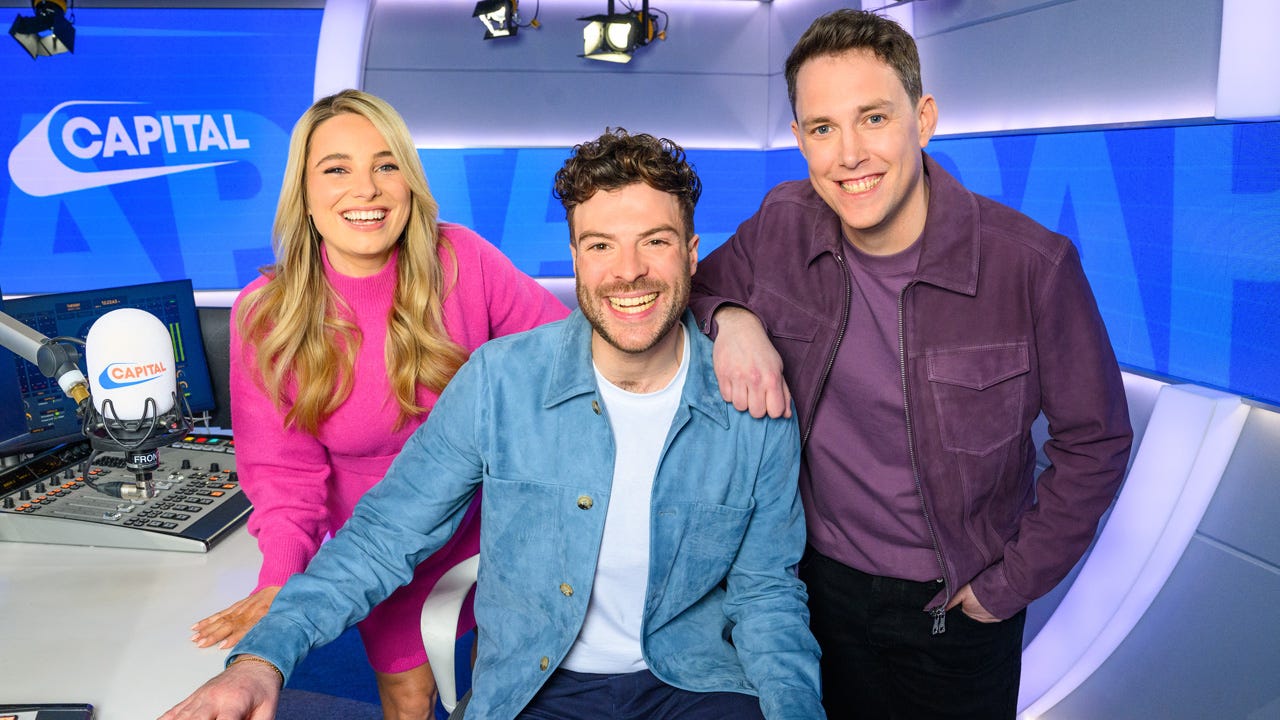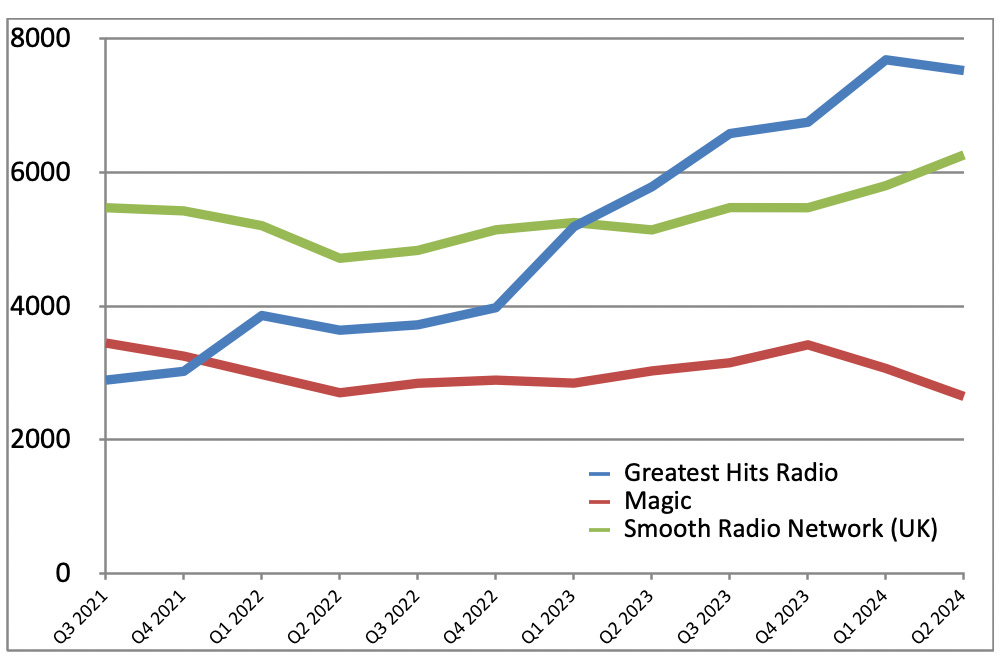RAJAR Q2/2024
Presenter swapping and a battle for the oldies
I get to quickly review the RAJAR data by using the excellent Octagon from Hallett Arendt. Go check it out if you need to do that too!
With some of the quarterly results of the RAJARs - the UK’s radio ratings - there just seems to be plenty of good news. It usually coincides with the population update. This time around the population universe is up to 57.6m from 56.3m and radio listeners are up to 50.8m from 49.9m which means there’s more people to play with!
Before we get to that though, a quick look at the platforms. DAB has its highest ever reach with 71.4% of the UK (that’s 36.2m people) tuning in. AM/FM is listened to by 55.3% and 29.4% consume through a smart speaker. When we look at share - the amount of listening - DAB is the largest with 42.8%, AM/FM’s hit a new low at 26.3% with DTV at 2.7%. 11.1% of listening is through a phone, the web or internet radios whilst 17% of all listening is through a smart speaker (a new high).
The changing nature of consumption means DAB is pretty essential for radio stations now - if you don’t show up on that dial, the available time people can give to you is very low. Whilst anyone can be on smart speakers, its essential that stations stay top of mind. With presets you can occupy a place on a radio, but with voice listeners have to remember to ask for you.
I think for smaller radio stations, especially ones that are an occasional listen, significant thought has to go in marketing touch points - newsletters, social, outdoor etc - to remind people you exist and to provide a value proposition - a ‘why’ to tune in.
A change of presenters is one way to attract attention for radio stations. We’ve talked much about Ken Bruce swapping from BBC Radio 2 to Greatest Hits Radio, but at the beginning of this quarter, Radio 1’s Jordan North crossed the street to start on the Capital Breakfast Show.
Jordan isn’t on Capital Scotland and their Welsh-language opt-out, but is still across most of ‘Capital Network UK’. The figures for his 6am to 10am slot show an increase quarter on quarter and year on year from 2.6m to 2.9m - but this data includes two quarters - the one before he started as well.
Looking at the data for Capital London - which is measured on a single quarter - you can see a q-on-q increase from 654k to 792k and similar for the year on year figure. He seems to have definitely made an impact. It’s also helped Capital’s total listening too, with y-o-y reach up nearly a million from 6.01m to 6.99m. Q-on-q they’re up from 6.2m.
Over at Radio 1 you would expect them to have seen a bit of an impact, but they’ve had a pretty good book, with the station jumping q-on-q from 7.3m to 8.1m (y-on-y is up from 7.6m).
Comparing the 6am to 10am time period Greg James (who’s on for most of that) has managed to grow his audience from 3.8m to 3.9m, no mean feat with competition from his ex-colleague. However over on Jordan’s old Drivetime slot the growth has been even more substantial - up to 3.3m (a q-on-q increase from 2.8m and y-on-y from 3.0m).
Over at the other main youth station Kiss, Radio 1 and Capital’s strength has not been helpful. It’s down to a reach of 2m (a nearly 300k drop q-on-q and nearly 500k y-on-y). 150k of that quarterly loss is in London. The Kiss Network’s reach remains relatively stable over the last year, a little down, but still delivering 4m. The hours drop from 21m to 17.8m will hurt though.
Kisstory is now bigger than the main Kiss with a weekly reach of 2.3m (up on the quarter, down on the year) and its hours of 9.6m is ahead of its stablemate’s 8.0m. Kiss suffers from younger audiences listening to the radio less and is not helped by little marketing from Bauer and an events focus on Kisstory.
It’s also has to contend with competition from Capital Dance which is now bringing in 1.1m listeners a week and 5.4m hours.
Older Stations
There’s an interesting battle happening between the slightly older targeted stations - Magic, Greatest Hits Radio, Smooth and BBC Radio 2.
GHR’s entry upset much of this older end, with Radio 2 dropping from 14.5m post-pandemic to 13.3m now. It impacted Smooth’s reach, but with a music policy change, as well as some marketing, they’ve seen a return to growth. Similarly Magic was hit initially and then saw some slow growth. A schedule change, and a lack of marketing to support it (and as of yesterday the loss of Ronan Keating on Breakfast) puts it in a difficult position.
GHR though may have peaked, it saw its national reach drop slightly from 7.6m to 7.5m. I think this means the other stations now have a chance to reset and see where they can find space in the market.
So what are they all doing? Well, usually these write-ups are quite text based for something that talks about audio! You might not be a regular listener to BBC Radio 2, Magic, Smooth and GHR - but could you guess what they sound like? I’ve compiled a mix of the music from the 8am hour yesterday, can you guess which is which? I’ll reveal the answers below.
Number 1:
Number 2:
Number 3:
Number 4:
When we look at the reach profile for each station - the percentage of audience in each demographic, it’s an interesting mix…
Radio 2’s the oldest - with half of its audience over 55, and GHR a little older than Smooth.
I’m not a regular listener to any of those stations, but as a 45 year-old, gulp, I’m probably in the demo for most of them. I felt that GHR seemed quite old sounding, the lack of any contemporary songs is noticeable. I thought the Smooth Radio mix was pretty good, significantly more upbeat than it used it to be and it didn’t feel as old, it has definitely been reinvented as a solid AC. Magic is obviously a mix of contemporary and classics and very listenable. Radio 2 had the highest number of songs unfamiliar to me - particularly the country-infused ones - and was surprisingly contemporary when you look at the demographic mix. Their repositioning to better cater for the 35-45s is certainly noticeable but I feel for the oldies.
So what were they all? Well, Number 1 was Radio 2, Number 2 was Magic, Number 3 was Smooth and Number 4 was GHR. Is it what you thought? Tell me in the comments!
Elsewhere
Over at News UK, talkSPORT is celebrating its best ever reach with the network delivering 3.7m listeners. Times Radio is still pretty stationary with 478k reach, now overtaken by the audio feed of GB News with 518k. The loss of Matt Chorley to Five Live is probably unlikely to help. talkRADIO saw its reach fall back a little to 690k (from 757k) not helped by a constantly changing schedule in the wake of all of the Talk TV machinations.
The main Virgin Radio is up 8% to 1.6m and the network as a whole up 14% to 2.1m. Irish import Ryan Tubridy is up to 503k, a q-on-q rise from 457k and y-on-y from 488k. Chris Evans delivers 900k across the network, up marginally q-on-q and up from 863k y-on-y.
Radio X has delivered its highest ever reach of 2.3m. Moyles delivers 1.2m and Johnny Vaughan’s over 1m for the first time. A best ever result for the Absolute Radio Network too - now reaching 5.6m.
Another best ever for Fun Kids - its London 10+ reach is 142k.
Over at BBC Local Radio in England I imagine a sigh of relief with numbers stabilising, if not really growing. They’re up around 100k q-on-q to 4.8m (but down from 5.5m y-on-y). What’s that looking like across the schedule?
A quick glance would suggest that the many breakfast show changes have hit the network hard, with mid-mornings performing a little better. The least affected is the most regionalised - afternoons. Late evenings seems quite challenged too.
Also check out Radio Today’s round up and Adam Bowie’s analysis too.







Good game, and I did get them right! Mix 1 is really well crafted, excellent variety from song to song covering a range distinctive to Radio 2. Mix 2 felt comparatively very samey and unrewarding, and while I’m not a listener, it felt like a station playing this at breakfast would be in decline (sorry Magic). It was harder than I expected to tell the difference between Smooth and GHR - first track in Mix 3 had me very confident it was Smooth, and there’s a beautiful balance of consistency and variety that’s hard to get right - good work! - and it feels like it’s broadened out lately. GHR’s Mix 4 is also very strong on variety, with a bit more eclectic range - could have been R2 except for the lack of new tracks. Let’s play this again next time!
Mix 1. I guessed this was Radio 2. Awful. I mean seriously, George Ezra, Sabrina Carpenter, Olivia Dean, Morgan Wade! These are all artists better suited to kids parties.
Although their remit is to serve a 35+ audience, It’s clear the direction of the station has been to try and appeal to the bottom end of that demographic more than the upper end. I'm only 50s but cannot resonate with Radio 2 at all these days.
I was reading some BDRC audience research figures which revealed that although Radio 2's core audience is supposed to be everyone over 35 years, 31% of UNDER 35s think it is aimed at their age group! And this is where things are going wrong. The programming and choice of presenters is driving the appeal to a much younger demographic and in terms of pop music, they have abandoned the top end.
Mix 2. Has all the hallmarks of Magic. Bland bland and bland. Not for me.
Mix 3. I guessed Smooth but increasingly it's another station that's widening the music output to things I wouldn't consider Smooth at all.
Mix 4. GHR seems to have things spot on for the demographic Radio 2 abandoned. Loved the examples you played and with younger audiences in decline I do hope BBC Radio 2 are punished for moving the demographic goalposts and GHR carry on piling on new listeners.
In summary, I have no interest in BBC Radio 2 these days. Magic is far too bland. I could be ok with Smooth but GHR wins.
(I think Boom are doing good things too and Boom Lite is wonderful and reminds me of an old BBC Radio 2 show (when they appealed to over 40s) called Sunday Night is Music Night with David Jacobs.